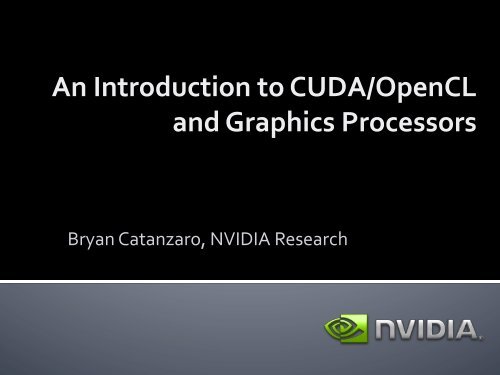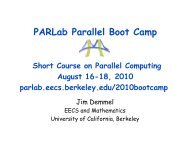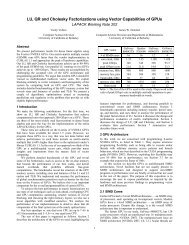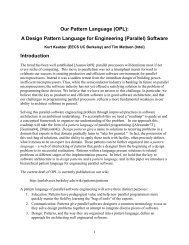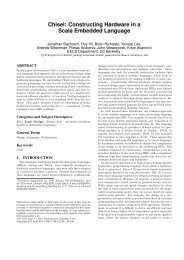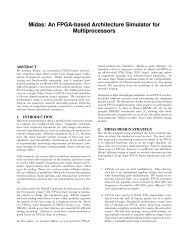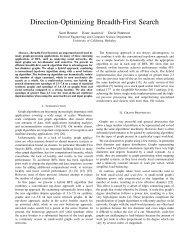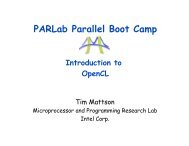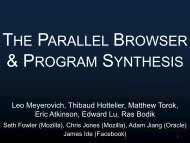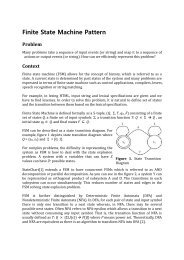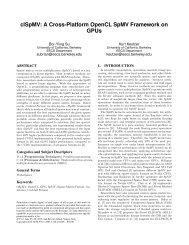Slides - Par Lab
Slides - Par Lab
Slides - Par Lab
You also want an ePaper? Increase the reach of your titles
YUMPU automatically turns print PDFs into web optimized ePapers that Google loves.
An Introduction to CUDA/OpenCL and Graphics Processors Bryan Catanzaro, NVIDIA Research
What is a CUDA Thread? ¡ Independent thread of execution § has its own program counter, variables (registers), processor state, etc. § no implication about how threads are scheduled ¡ CUDA threads might be physical threads § as mapped onto NVIDIA GPUs ¡ CUDA threads might be virtual threads § might pick 1 block = 1 physical thread on multicore CPU 12/73
What is a CUDA Thread Block? ¡ Thread block = a (data) parallel task § all blocks in kernel have the same entry point § but may execute any code they want ¡ Thread blocks of kernel must be independent tasks § program valid for any interleaving of block executions 13/73
CUDA Supports: ¡ Thread parallelism § each thread is an independent thread of execution ¡ Data parallelism § across threads in a block § across blocks in a kernel ¡ Task parallelism § different blocks are independent § independent kernels executing in separate streams 14/73
Synchronization ¡ Threads within a block may synchronize with barriers … Step 1 … __syncthreads(); … Step 2 … ¡ Blocks coordinate via atomic memory operations §e.g., increment shared queue pointer with atomicInc() ¡ Implicit barrier between dependent kernels vec_minus(a, b, c); vec_dot(c, c); 15/73
Blocks must be independent ¡ Any possible interleaving of blocks should be valid § presumed to run to completion without pre-‐emption § can run in any order § can run concurrently OR sequentially ¡ Blocks may coordinate but not synchronize § shared queue pointer: OK § shared lock: BAD … can easily deadlock ¡ Independence requirement gives scalability 16/73
Scalability ¡ Manycore chips exist in a diverse set of configurations 35 Number of SMs 30 25 20 15 10 5 0 8300GS 9400M 8800GTX GTX285 ¡ CUDA allows one binary to target all these chips ¡ Thread blocks bring scalability! 17/73
Hello World: Vector Addition //Compute vector sum C=A+B //Each thread performs one pairwise addition __global__ void vecAdd(float* a, float* b, float* c) { int i = blockIdx.x * blockDim.x + threadIdx.x; c[i] = a[i] + b[i]; } int main() { //Run N/256 blocks of 256 threads each vecAdd(d_a, d_b, d_c); } 18/73
Memory model Thread Per-‐thread Local Memory BlockPer-‐block Shared Memory 19/73
Memory model Kernel 0 Sequential Kernels Kernel 1 … … Per Device Global Memory 20/73
Using per-‐block shared memory ¡ Variables shared across block __shared__ int *begin, *end; ¡ Scratchpad memory __shared__ int scratch[BLOCKSIZE]; scratch[threadIdx.x] = begin[threadIdx.x]; // … compute on scratch values … begin[threadIdx.x] = scratch[threadIdx.x]; ¡ Communicating values between threads Block scratch[threadIdx.x] = begin[threadIdx.x]; __syncthreads(); int left = scratch[threadIdx.x -‐ 1]; ¡ Per-‐block shared memory is faster than L1 cache, slower than register file ¡ It is relatively small: register file is 2-‐4x larger Shared 24/73
CUDA: Features available on GPU ¡ Double and single precision (IEEE compliant) ¡ Standard mathematical functions § sinf, powf, atanf, ceil, min, sqrtf, etc. ¡ Atomic memory operations § atomicAdd, atomicMin, atomicAnd, atomicCAS, etc. ¡ These work on both global and shared memory 25/73
CUDA: Runtime support ¡Explicit memory allocation returns pointers to GPU memory §cudaMalloc(), cudaFree() ¡¡¡Explicit memory copy for host ↔ device, device ↔ device §cudaMemcpy(), cudaMemcpy2D(), ... Texture management §cudaBindTexture(), cudaBindTextureToArray(), ... OpenGL & DirectX interoperability §cudaGLMapBufferObject(), cudaD3D9MapVertexBuffer(), … 26/73
OpenCL ¡ OpenCL is supported by AMD {CPUs, GPUs} and Nvidia § Intel, Imagination Technologies (purveyor of GPUs for iPhone/etc.) are also on board ¡ OpenCL’s data parallel execution model mirrors CUDA, but with different terminology ¡ OpenCL has rich task parallelism model § Runtime walks a dependence DAG of kernels/memory transfers *#+,"&)*#+,"&'!"#$"%&'!"#$"%&(*#+,"&(!"#$"%&-!"#$"%&)."/0&'."/0&(27/73
CUDA and OpenCL correspondence ¡ Thread ¡ Thread-‐block ¡ Global memory ¡ Constant memory ¡ Shared memory ¡ Local memory ¡ __global__ function ¡ __device__ function ¡ __constant__ variable ¡ __device__ variable ¡ __shared__ variable ¡ Work-‐item ¡ Work-‐group ¡ Global memory ¡ Constant memory ¡ Local memory ¡ Private memory ¡ __kernel function ¡ no qualification needed ¡ __constant variable ¡ __global variable ¡ __local variable 28/73
OpenCL and SIMD ¡ SIMD issues are handled separately by each runtime ¡ AMD GPU Runtime § Vectorizes over 64-‐way SIMD ▪ Prefers scalar code per work-‐item (on newer AMD GPUs) ¡ AMD CPU Runtime § No vectorization ▪ Use float4 vectors in your code (float8 when AVX appears?) ¡ Intel CPU Runtime § Vectorization optional, using float4/float8 vectors still good idea ¡ Nvidia GPU Runtime § Full vectorization, like CUDA ▪ Prefers scalar code per work-‐item 29/73
Imperatives for Efficient CUDA Code ¡ Expose abundant fine-‐grained parallelism § need 1000’s of threads for full utilization ¡ Maximize on-‐chip work § on-‐chip memory orders of magnitude faster ¡ Minimize execution divergence § SIMT execution of threads in 32-‐thread warps ¡ Minimize memory divergence § warp loads and consumes complete 128-‐byte cache line 30/73
Mapping CUDA to Nvidia GPUs ¡ CUDA is designed to be functionally forgiving § First priority: make things work. Second: get performance. ¡ However, to get good performance, one must understand how CUDA is mapped to Nvidia GPUs ¡ Threads: each thread is a SIMD vector lane ¡ Warps: A SIMD instruction acts on a “warp” § Warp width is 32 elements: LOGICAL SIMD width ¡ Thread blocks: Each thread block is scheduled onto an SM § Peak efficiency requires multiple thread blocks per SM 31/73
Mapping CUDA to a GPU, continued ¡ The GPU is very deeply pipelined to maximize throughput ¡ This means that performance depends on the number of thread blocks which can be allocated on a processor ¡ Therefore, resource usage costs performance: § More registers => Fewer thread blocks § More shared memory usage => Fewer thread blocks ¡ It is often worth trying to reduce register count in order to get more thread blocks to fit on the chip § For Kepler, target 32 registers or less per thread for full occupancy 32/73
Occupancy (Constants for Kepler) ¡ The Runtime tries to fit as many thread blocks simultaneously as possible on to an SM § The number of simultaneous thread blocks (B) is ≤ 8 ¡ The number of warps per thread block (T) ≤ 32 ¡ Each SM has scheduler space for 64 warps (W) § B * T ≤ W=64 ¡ The number of threads per warp (V) is 32 ¡ B * T * V * Registers per thread ≤ 65536 ¡ B * Shared memory (bytes) per block ≤ 49152/16384 § Depending on Shared memory/L1 cache configuration ¡ Occupancy is reported as B * T / W 33/73
Profiling NVIDIA Visual Profiler© NVIDIA Corporation 2012¡ nvvp (nvidia visual profiler) useful for interactive profiling ¡ export CUDA_PROFILE=1 in shell for simple profiler § Then examine cuda_profile_*.log for kernel times & occupancies 34/73
SIMD & Control Flow ¡ Nvidia GPU hardware handles control flow divergence and reconvergence § Write scalar SIMD code, the hardware schedules the SIMD execution § One caveat: __syncthreads() can’t appear in a divergent path ▪ This may cause programs to hang § Good performing code will try to keep the execution convergent within a warp ▪ Warp divergence only costs because of a finite instruction cache 35/73
Memory, Memory, Memory ! Chapter 1. Introduction to CUDA¡ A many core processor ≡ A device for turning a compute "#$%&'(')#*!+!,-("'./!01('!23(%1)"4!3,*5,3)*2!)4!(6#&'!+!(*5!'1,3,7#3,!5,4)2*,5! bound problem into a memory bound problem 4&"1!'1('!$#3,!'3(*4)4'#34!(3,!5,8#',5!'#!5('(!%3#",44)*2!3('1,3!'1(*!5('(!"("1)*2!(*5!7.#0!"#*'3#.9!(4!4"1,$(')"(../!)..&4'3(',5!6/!:)2&3,!;!!Kathy Yelick, Berkeley ControlALUALUALUALUCacheDRAMDRAM¡ Lots of processors, only one socket Figure 1-2.GPU!The GPU Devotes More Transistors to DataProcessing¡ Memory concerns dominate performance tuning !CPU36/73
Memory is SIMD too ¡ Virtually all processors have SIMD memory subsystems 0 1 2 3 4 5 6 7 ¡ This has two effects: cache line width ¡ Sparse access wastes bandwidth 0 1 2 3 4 5 6 7 ¡ Unaligned access wastes bandwidth 0 1 2 3 4 5 6 7 2 words used, 8 words loaded: ¼ effective bandwidth 4 words used, 8 words loaded: ½ effective bandwidth 37/73
Coalescing ¡ GPUs and CPUs both perform memory transactions at a larger granularity than the program requests (“cache line”) ¡ GPUs have a “coalescer”, which examines memory requests dynamically from different SIMD lanes and coalesces them ¡ To use bandwidth effectively, when threads load, they should: § Present a set of unit strided loads (dense accesses) § Keep sets of loads aligned to vector boundaries 38/73
Data Structure Padding L(row major) ¡ Multidimensional arrays are usually stored as monolithic vectors in memory ¡ Care should be taken to assure aligned memory accesses for the necessary access pattern J39/73
SoA, AoS ¡ Different data access patterns may also require transposing data structures T Array of Structs Structure of Arrays ¡ The cost of a transpose on the data structure is often much less than the cost of uncoalesced memory accesses ¡ Use shared memory to handle block transposes 40/73
Efficiency vs Productivity" Productivity is often in tension with efficiency" This is often called the “abstraction tax”Efficiency LanguageProductivity LanguageLow levelC!High levelLess ProductiveFastSlowMore Productive© 2011 NVIDIA Corporation 41/73
Efficiency and Productivity" <strong>Par</strong>allel programming also gives us a “concrete tax”" How many of you have tried to write … which is faster than avendor supplied library?FFTSGEMMSortScanReduce" Divergent <strong>Par</strong>allel Architectures means performanceportability is increasingly elusive" Low-level programming models tie you to a particularpiece of hardware" And if you’re like me, often make your code slow" My SGEMM isn’t as good as NVIDIA’s© 2011 NVIDIA Corporation 42/73
The Concrete Tax: A Case Study" K-means clustering" Someone came to me complaining of slow code" Multi-thousands of lines of OpenCL" Hybrid reduction between CPU and GPU" I rewrote it using Thrust and CUBLAS" Very simple, unoptimized kernels" 60 times faster" http://github.com/BryanCatanzaro/kmeans© 2011 NVIDIA Corporation 43/73
Abstraction, cont." Reduction is one of the simplest parallel computations" Performance differentials are even starker as complexityincreases" There’s a need for abstractions at many levels" Primitive computations (BLAS, Data-parallel primitives)" Domain-specific languages" These abstractions make parallel programming moreefficient and more productive" Use libraries whenever possible!" CUBLAS, CUFFT, Thrust© 2011 NVIDIA Corporation 44/73
" A C++ template library for CUDA" Mimics the C++ STL" Containers" On host and device" Algorithms" Sorting, reduction, scan, etc.© 2011 NVIDIA Corporation 45/73
Diving In#include #include #include #include int main(void){// generate 32M random numbers on the hostthrust::host_vector h_vec(32
Objectives" Programmer productivity" Build complex applications quickly" Encourage generic programming" Leverage parallel primitives" High performance" Efficient mapping to hardware© 2011 NVIDIA Corporation 47/73
Containers" Concise and readable code" Avoids common memory management errors// allocate host vector with two elementsthrust::host_vector h_vec(2);// copy host vector to devicethrust::device_vector d_vec = h_vec;// write device values from the hostd_vec[0] = 13;d_vec[1] = 27;// read device values from the hoststd::cout
Iterators" Pair of iterators defines a range// allocate device memorydevice_vector d_vec(10);// declare iterator variablesdevice_vector::iterator begin =d_vec.begin();device_vector::iterator end = d_vec.end();device_vector::iterator middle = begin + 5;// sum first and second halvesint sum_half1 = reduce(begin, middle);int sum_half2 = reduce(middle, end);// empty rangeint empty = reduce(begin, begin);© 2011 NVIDIA Corporation 49/73
Iterators" Iterators act like pointers// declare iterator variablesdevice_vector::iterator begin = d_vec.begin();device_vector::iterator end = d_vec.end();// pointer arithmeticbegin++;// dereference device iterators from the hostint a = *begin;int b = begin[3];// compute size of range [begin,end)int size = end - begin;© 2011 NVIDIA Corporation 50/73
Iterators" Encode memory location" Automatic algorithm selection// initialize random values on hosthost_vector h_vec(100);generate(h_vec.begin(), h_vec.end(), rand);// copy values to devicedevice_vector d_vec = h_vec;// compute sum on hostint h_sum = reduce(h_vec.begin(), h_vec.end());// compute sum on deviceint d_sum = reduce(d_vec.begin(), d_vec.end());© 2011 NVIDIA Corporation 51/73
Algorithms" Elementwise operations" for_each, transform, gather, scatter …" Reductions" reduce, inner_product, reduce_by_key …" Prefix-Sums" inclusive_scan, inclusive_scan_by_key …" Sorting" sort, stable_sort, sort_by_key …© 2011 NVIDIA Corporation 52/73
Algorithms" Standard operators// allocate memorydevice_vector A(10);device_vector B(10);device_vector C(10);// transform A + B -> Ctransform(A.begin(), A.end(), B.begin(), C.begin(), plus());// transform A - B -> Ctransform(A.begin(), A.end(), B.begin(), C.begin(), minus());// multiply reductionint product = reduce(A.begin(), A.end(), 1, multiplies());© 2011 NVIDIA Corporation 53/73
Algorithms" Standard data types// allocate device memorydevice_vector i_vec = ...device_vector f_vec = ...// sum of integersint i_sum = reduce(i_vec.begin(), i_vec.end());// sum of floatsfloat f_sum = reduce(f_vec.begin(),f_vec.end());© 2011 NVIDIA Corporation 54/73
Custom Types & Operatorsstruct negate_float2{__host__ __device__float2 operator()(float2 a){return make_float2(-a.x, -a.y);}};// declare storagedevice_vector input = ...device_vector output = ...// create function object or functornegate_float2 func;// negate vectorstransform(input.begin(), input.end(), output.begin(), func);© 2011 NVIDIA Corporation 55/73
Custom Types & Operators// compare x component of two float2 structuresstruct compare_float2{__host__ __device__bool operator()(float2 a, float2 b){return a.x < b.x;}};// declare storagedevice_vector vec = ...// create comparison functorcompare_float2 comp;// sort elements by x componentsort(vec.begin(), vec.end(), comp);© 2011 NVIDIA Corporation 56/73
Interoperability" Convert iterators to raw pointers// allocate device vectorthrust::device_vector d_vec(4);// obtain raw pointer to device vector’s memoryint * ptr = thrust::raw_pointer_cast(&d_vec[0]);// use ptr in a CUDA C kernelmy_kernel>(N, ptr);// Note: ptr cannot be dereferenced on the host!© 2011 NVIDIA Corporation 57/73
Recap" Containers manage memory" Help avoid common errors" Iterators define ranges" Know where data lives" Algorithms act on ranges" Support general types and operators© 2011 NVIDIA Corporation 58/73
Explicit versus implicit parallelism" CUDA is explicit" Programmer’s responsibility to schedule resources" Decompose algorithm into kernels" Decompose kernels into blocks" Decompose blocks into threadsKernel 1…Kernel 2……© 2011 NVIDIA Corporation 59/73
Explicit versus implicit parallelism" SAXPY in CUDA__global__void SAXPY(int n, float a, float * x, float * y){int i = blockDim.x * blockIdx.x + threadIdx.x;}if (i < n)y[i] = a * x[i] + y[i];SAXPY >(n, a, x, y);© 2011 NVIDIA Corporation 60/73
Explicit versus implicit parallelism" SAXPY in CUDA__global__void SAXPY(int n, float a, float * x, float * y){int i = blockDim.x * blockIdx.x + threadIdx.x;}if (i < n)y[i] = a * x[i] + y[i];SAXPY >(n, a, x, y);Decomposition© 2011 NVIDIA Corporation 61/73
Explicit versus implicit parallelism" SAXPY in Thrust// C++ functor replaces __global__ functionstruct saxpy {float a;saxpy(float _a) : a(_a) {}};__host__ __device__float operator()(float x, float y) {return a * x + y;}transform(x.begin(), x.end(), y.begin(), y.begin(),saxpy(a));© 2011 NVIDIA Corporation 62/73
Implicitly <strong>Par</strong>allel" Algorithms expose lots of fine-grained parallelism" Generally expose O(N) independent threads of execution" Minimal constraints on implementation details" Programmer identifies opportunities for parallelism" Thrust determines explicit decomposition onto hardware" Finding parallelism in sequential code is hard" Mapping parallel computations onto hardware is easier© 2011 NVIDIA Corporation 63/73
Productivity Implications" Consider a serial reduction// sum reductionint sum = 0;for(i = 0; i < n; ++i)sum += v[i];© 2011 NVIDIA Corporation 64/73
Productivity Implications" Consider a serial reduction// product reductionint product = 1;for(i = 0; i < n; ++i)product *= v[i];© 2011 NVIDIA Corporation 65/73
Productivity Implications" Consider a serial reduction// max reductionint max = 0;for(i = 0; i < n; ++i)max = std::max(max,v[i]);© 2011 NVIDIA Corporation 66/73
Productivity Implications" Compare to low-level CUDAint sum = 0;for(i = 0; i < n; ++i)sum += v[i];__global__void block_sum(const float *input,float *per_block_results,{const size_t n)extern __shared__ float sdata[];unsigned int i = blockIdx.x *blockDim.x + threadIdx.x;// load input into __shared__ memoryfloat x = 0;if(i < n){x = input[i];© 2011 NVIDIA Corporation 67/73...
Leveraging <strong>Par</strong>allel Primitives" Use sort liberallydata type std::sort tbb::parallel_sort thrust::sortchar 25.1 68.3 3532.2short 15.1 46.8 1741.6int 10.6 35.1 804.8long 10.3 34.5 291.4float 8.7 28.4 819.8double 8.5 28.2 358.9Intel Core i7 950 NVIDIA GeForce 480© 2011 NVIDIA Corporation 68/73
Input-Sensitive Optimizations© 2011 NVIDIA Corporation 69/73
Leveraging <strong>Par</strong>allel Primitives" Combine sort with reduce_by_key" Keyed reduction" Bring like items together, collapse" Poor man’s MapReduce" Can often be faster than custom solutions" I wrote an image histogram routine in CUDA" Bit-level optimizations and shared memory atomics" Was 2x slower than thrust::sort +thrust::reduce_by_key© 2011 NVIDIA Corporation 70/73
Thrust on github" Quick Start Guide" Examples" Documentation" Mailing list (thrust-users)© 2011 NVIDIA Corporation 71/73
Summary ¡ Throughput optimized processors complement latency optimized processors ¡ Programming models like CUDA and OpenCL enable heterogeneous parallel programming ¡ They abstract SIMD, making it easy to use wide SIMD vectors ¡ CUDA and OpenCL encourages SIMD friendly, highly scalable algorithm design and implementation ¡ Thrust is a productive C++ library for parallel programming ¡ Start with libraries when doing parallel programming! 72/73
Questions? Bryan Catanzaro bcatanzaro@nvidia.com http://research.nvidia.com 73/73


